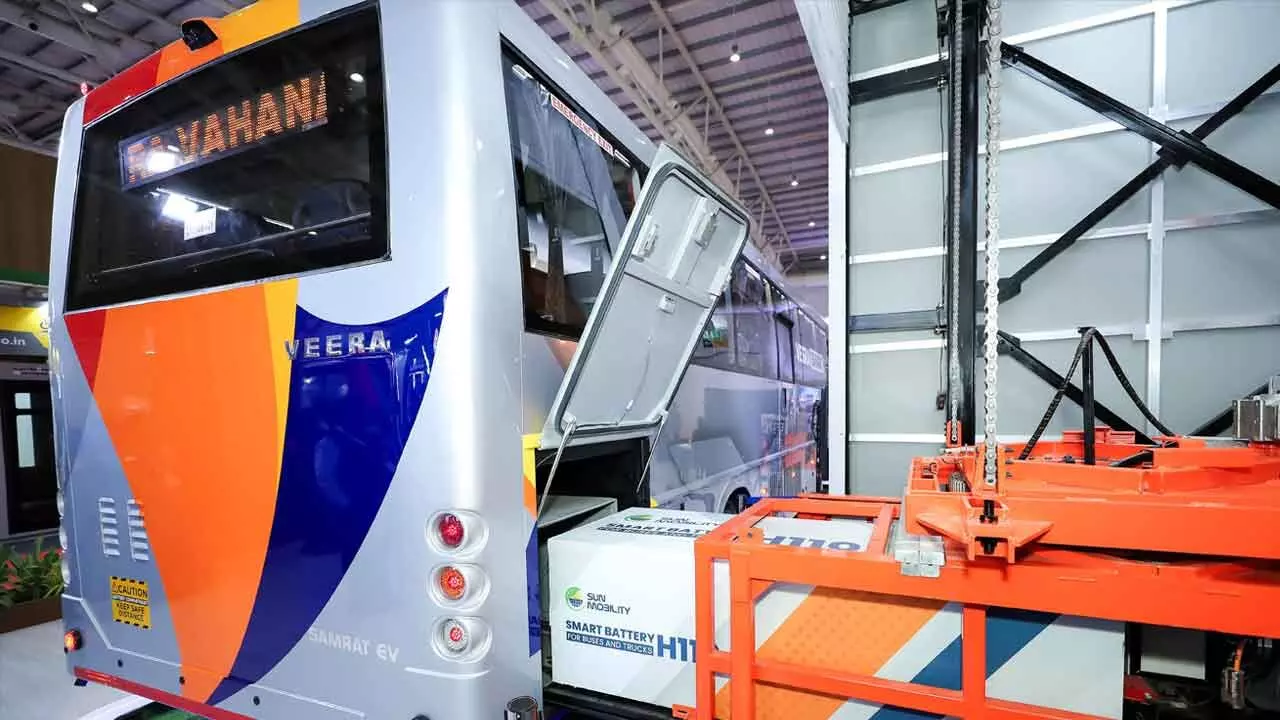Battery swapping can be a game changer for Indian commercial vehicles

SUN Mobility’s solution stands out with its modular and scalable battery packs, designed to cater to a wide range of commercial vehicles—from 7-metre buses to 13.5-metre buses and commercial vehicles ranging from three tonnes to 55 tonnes.
India aspires to be energy-independent by 2047, the centenary year of its freedom. In this pursuit, decarbonisation of the commercial vehicle segment, especially heavy-duty buses and trucks, will be imperative. Occupying less than five per cent of the total vehicle fleet, heavy-duty buses and trucks account for about half of transport-related emissions.
Electric vehicles (EVs) have emerged as a leading technology in decarbonization, particularly in smaller segments like two and three-wheelers. However, the challenge of electrifying heavy commercial vehicles (HCVs) remains formidable due to their demanding energy requirements and operational complexities.
Globally, battery swapping has emerged as a promising solution for electrifying heavy electric vehicles (HEVs).
Electric buses have seen significant traction in regions like China and Kenya. BasiGo in Kenya and Shenzen bus group in China procured buses without pre-fitted batteries. In Germany, the eHaul project while Ample and Yamato in Japan are also conducting dedicated swapping pilots for HEVs.
In India, electrification of vehicles has been driven by a suite of policy support, fiscal subsidies, and the entry of new-age startups. However, the focus on HEV electrification has been limited. The recently launched PM E-bus Sewa and the State Transport Undertaking (STU) focused bus electrification through FAME subsidy is concentrating on the urban bus fleet, which has a miniscule share of the Indian bus market. Fleet operators in India face several challenges in transitioning to electric vehicles as around 90 per cent of the country’s overall bus market is operated by fragmented private fleet owners, the majority of who have less than five buses and do not have access to subsidies and finance.
For commercial vehicles ranging from three tonnes to 55 tonnes, electrification is hindered owing to challenges like high upfront cost, longer charging times, battery obsolescence, and range anxiety.
There is a limited and uneven distribution of charging and battery-swapping stations across India, particularly outside major urban areas. This limits the practicality of EVs for long-distance or intercity travel, where reliable access to charging is critical.
Battery Swapping is the best bet:
To this end, battery swapping can be a game-changing opportunity for electrification for buses and trucks. It provides myriad benefits namely: zero downtime, increased productivity by 30 per cent, alleviated battery obsolescence concerns, reduced anxiety about battery performance and vehicle range, and improved affordability of HEVs.
First, battery swapping improves the affordability of heavy electric vehicles (HEVs) by significantly reducing the upfront cost.
Second, it alleviates the customers’ challenge of battery obsolescence by disassociating the battery from the vehicle. The customer need not worry about the high battery replacement cost over time, the battery performance, and the evolving battery technologies itself.
Third, battery swapping offers a transformative solution to one of the most significant challenges in the adoption of electric vehicles: long charging times and the associated high-power demand from the grid.
Fourth, the ability to quickly swap batteries eliminates concerns like longer waiting time and a dense battery swapping network will eliminate range anxiety. The flexibility to swap the vehicle at ease is crucial for the heavy-duty segment, where reliability and uptime are paramount.
Fifth, once the battery is disassociated from the vehicle, the upfront cost is reduced, and the obsolescence related to technology and its performance is also mitigated as it is taken care of by the battery swap operator. This makes it a lucrative option for financial institutions to fund at par with the ICE vehicles.
In addition to the above benefits, SUN Mobility’s solution stands out with its modular and scalable battery packs, designed to cater to a wide range of commercial vehicles—from 7-metre buses to 13.5-metre buses and commercial vehicles ranging from three tonnes to 55 tonnes. This versatility offers fleet operators a unified energy solution across their diverse vehicle portfolio, reducing the need for multiple battery types and simplifying maintenance and logistics.
These measures backed by appropriate policy push will open the floodgates for EVs in India. By integrating battery swapping into the electrification strategy for heavy-duty trucks and buses, India can significantly reduce its carbon footprint, enhance energy security, and position itself as a global leader in green mobility.
(The writer is CEO- HEV, SUN Mobility)